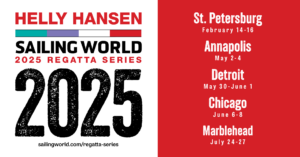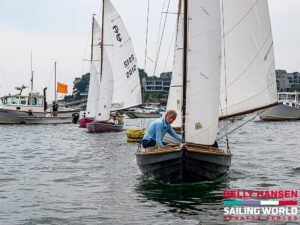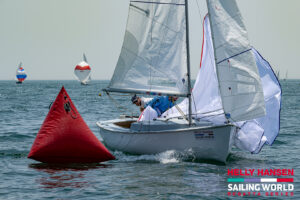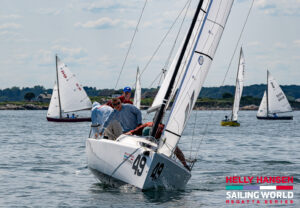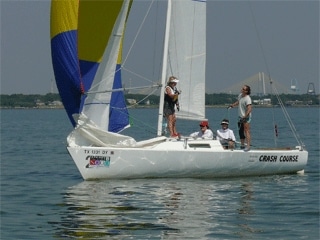
On the B division racecourse on Day 1 of the Sperry Top-Sider Texas NOOD, it was hot and there wasn’t a whole lot of wind. Everyone looked hot, sweaty, and frustrated except for one Catalina 22 skipper who was sporting a Twenty X-brand cowboy hat. Gene Ferguson is his name, and his results are as hot as his hat is cool; he and his solitary crew, Bret Stewart, ended the day with a 2,1,1 scoreline and a firm grip on first place. Ferguson, who turned 76 last month, has been sailing Catalina 22s since 1977, this particular boat, Bulletproof, since 1986, when he made the transition from a fixed-keel 22 to a swing-keel model. Ferguson was frank about the conditions today: “It was terrible,” he said. “There was no wind, but I’ve got a good crew who keeps me honest. He’s always reminding me: ‘there’s a lift, keep it full.’ If I glance off somewhere he sees me. He’s young and he’s fast.” Stewart’s been sailing with Ferguson since 2003, and part of his skill comes from being an ex-owner of a Catalina 22, which could explain why Bulletproof does so well with only two people aboard to pull the strings. “It’s kind of a small boat, so fewer bodies is better,” says Stewart. “There are a lot of things to do at mark roundings, but you get the system down and everything’s OK.” Stewart was frank about the first race, which resulted in their worst result for the day. “We went the wrong way the first beat,” he says. “We try to understand who the competition is and who we should cover. While we were doing that, two other boats picked up some wind on the right side of the course. We were lucky, though, we snuck back in there at the last downwind leg and got second. Four boats finished within a boat length of each other in that race.”Ferguson, too, is frank about their plans for tomorrow. “Get a 1,1,1,” he says. “I don’t go out there unless I plan to win. Barry Bowden and Claude Welles spent the day easing the J/80 Wild Hare around the marks on the A Division racecourse and earning a 3,4 for the day. “We’re part of the geriatric J/80 fleet,” said Bowden. “We’ve got one 35-year-old on board to bring the average age down.” Welles, who skippers Wild Hare, said that their experience on Lake Travis, near Austin, Texas, helped a lot today. “We just tried to connect the puffs,” he said. “Crew weight was important, too. You had to keep it clustered together and up forward; sail it like a Laser, which we all sail.” What are the plans for the crew of Wild Hare at the end of Day 1? “Go out and drink, and bring more gasoline tomorrow,” said Welles.Ed Kangas, of La Porte, Texas, spent the day trimming the main on the J/105 Aftershock, even when the instruments were reading 0.0 knots of wind speed. “Light air is boring,” he said, “but I never stopped trimming. But I’m not tired and I’m ready for tomorrow.” Kangas’ skipper, Vic Forsyth, a geophysicist during the week, was pleased with their day, despite a worrisome first race. “At the weather mark of the last race, we were in ninth place, but we went from there to finish second,” he said. “Our goal at every NOOD is to be in the top four in every race, and we’re in good shape and tied for second.” Forsyth is making it sound easy, but admits it was a tough day on the water. “It was hard driving,” he said. “There was no groove. What saved us was seeing the wind to fill in from the north. Around here, if there’s no sea breeze by 2 p.m., there will be no sea breeze. We stayed in the middle of the course and looked for the breeze to fill in. We got lucky.” Tomorrow, Forsyth’s plan is simple, and the same as it was when they won the NOOD in 2002. “We’ll go out there and stay in the top four,” he said. “We’ll get clean air on the start and keep our heads in the game.”

